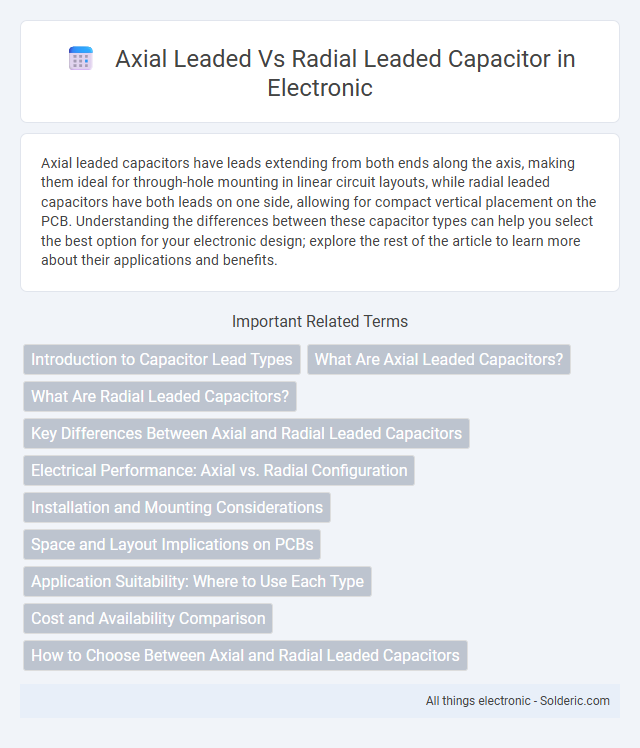Axial leaded capacitors have leads extending from both ends along the axis, making them ideal for through-hole mounting in linear circuit layouts, while radial leaded capacitors have both leads on one side, allowing for compact vertical placement on the PCB. Understanding the differences between these capacitor types can help you select the best option for your electronic design; explore the rest of the article to learn more about their applications and benefits.
Comparison Table
| Feature | Axial Leaded Capacitor | Radial Leaded Capacitor |
|---|---|---|
| Lead Orientation | Leads extend from opposite ends (axial) | Leads extend from the same side (radial) |
| PCB Mounting | Lies flat along the PCB surface | Stands perpendicular to PCB surface |
| Space Efficiency | Requires more board length | More compact, saves PCB space |
| Typical Applications | Vintage electronics, axial designs | Modern compact circuits, mass production |
| Mechanical Stability | Less stable under vibration | Better mechanical stability on PCB |
| Size Range | Often larger, high voltage | Smaller sizes, various voltages |
| Mounting Process | Manual or wave soldering preferred | Compatible with automated assembly |
Introduction to Capacitor Lead Types
Axial leaded capacitors feature leads extending from both ends along the capacitor's axis, making them ideal for insertion into narrow or linear circuit designs. Radial leaded capacitors have both leads emerging from the same side, providing compact mounting on PCBs and saving space in high-density electronic assemblies. Understanding these capacitor lead types helps you choose the appropriate component for your circuit layout and assembly requirements.
What Are Axial Leaded Capacitors?
Axial leaded capacitors feature leads extending from both ends along the component's axis, making them ideal for applications requiring compact, inline connections. Their cylindrical shape and axial leads allow for easy mounting on circuit boards with parallel lead placement, optimizing space in narrow or elongated designs. You will find axial leaded capacitors commonly used in older electronic devices, audio equipment, and circuit repairs where traditional lead orientation is preferred.
What Are Radial Leaded Capacitors?
Radial leaded capacitors feature two leads extending from the same side of the component, allowing for compact, efficient mounting on printed circuit boards (PCBs). These capacitors are commonly used in applications requiring low profile and easy automated assembly, such as in consumer electronics and power supplies. Their design supports higher density PCB layouts compared to axial leaded capacitors, which have leads on opposite ends.
Key Differences Between Axial and Radial Leaded Capacitors
Axial leaded capacitors feature leads extending from both ends along the capacitor's axis, enabling streamlined placement in through-hole circuit boards with a linear footprint. Radial leaded capacitors have both leads protruding from the same side, allowing for compact vertical mounting on PCBs, optimizing space in high-density applications. The choice between axial and radial depends on circuit layout, mechanical stability, and space constraints, with axial leads favored for inline component arrangements and radial leads preferred for perpendicular mounting efficiency.
Electrical Performance: Axial vs. Radial Configuration
Axial leaded capacitors typically offer better performance in high-frequency and pulse applications due to their lower parasitic inductance from straight lead configuration, resulting in improved signal integrity and reduced noise. Radial leaded capacitors, with leads emerging from the same side, provide a more compact footprint ideal for high-density circuit boards, but may exhibit slightly higher inductance affecting electrical performance in sensitive circuits. The choice between axial and radial configurations depends on balancing space constraints with the electrical requirements such as ESR (Equivalent Series Resistance) and ESL (Equivalent Series Inductance).
Installation and Mounting Considerations
Axial leaded capacitors feature leads extending from both ends, facilitating easy inline mounting on through-hole PCBs, ideal for tight, elongated spaces and wave soldering processes. Radial leaded capacitors have two leads protruding from one side, enabling compact, vertical mounting that saves board space and suits automated pick-and-place assembly for high-volume production. Selecting between axial and radial types depends on PCB layout constraints, assembly methods, and desired mechanical stability during installation.
Space and Layout Implications on PCBs
Axial leaded capacitors occupy more linear space on a PCB due to their lead orientation, making them suitable for designs where PCB height is less constrained. In contrast, radial leaded capacitors have leads on the same side, allowing for a more compact footprint and efficient use of PCB area, especially in high-density layouts. Your choice between axial and radial capacitors directly impacts the overall board size and component arrangement, influencing both manufacturing and performance.
Application Suitability: Where to Use Each Type
Axial leaded capacitors are ideal for applications requiring through-hole mounting in narrow spaces or linear circuit layouts, such as vintage electronics and PCB repairs. Radial leaded capacitors suit compact designs with low profile requirements, commonly used in modern surface-mount circuit boards and tightly spaced assemblies. Choosing between axial and radial leaded capacitors depends on board layout constraints, mechanical stability needs, and overall assembly process efficiency.
Cost and Availability Comparison
Axial leaded capacitors typically have lower production costs due to simpler manufacturing processes and are widely available for general-purpose applications. Radial leaded capacitors, while often more compact and suitable for automated assembly, may incur slightly higher costs but benefit from greater availability in high-capacitance and low-profile designs. Both types exhibit strong market presence, with radial capacitors dominating automated electronics manufacturing and axial capacitors favored in through-hole prototyping and repair tasks.
How to Choose Between Axial and Radial Leaded Capacitors
Choosing between axial and radial leaded capacitors depends on your PCB layout and space constraints. Axial lead capacitors are ideal for applications requiring components to lie flat along the board, saving height and fitting narrow spaces, while radial lead capacitors provide a compact footprint with leads extending from one side, making them suitable for densely populated boards. Your decision should consider the mounting style, mechanical stability, and ease of assembly to optimize circuit performance and reliability.
axial leaded vs radial leaded capacitor Infographic

 solderic.com
solderic.com